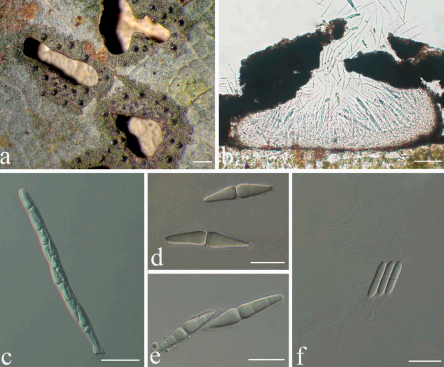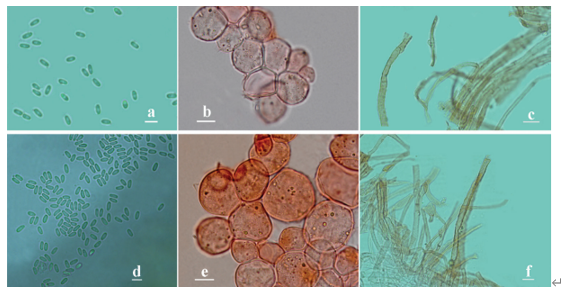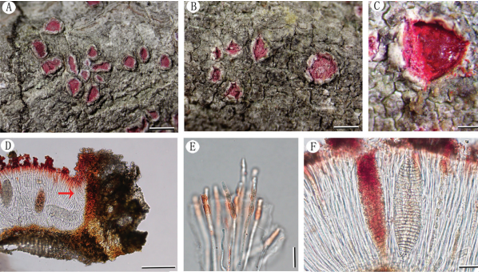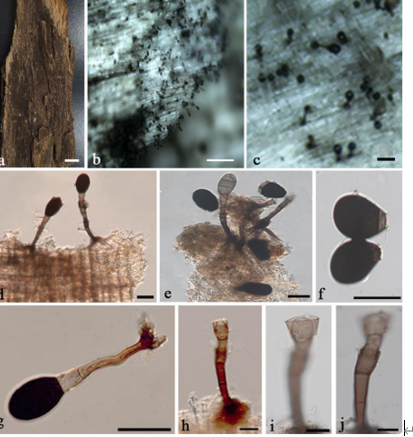Racoplaca macrospora S.H. Jiang, J.C. Wei & Lücking, sp. Nov.2021
MycoBank MB 838157
. Typus: CHINA, Guangdong, Shixing County, Chebaling National Nature Reserve, N 24°43′27″, E 114°15′22″, alt. 345 m, on living leaves, 14 May 2015, X.L. Wei & J.H. Wang GD2015020 (HMAS–L0139170, holotype; ITS Genbank No. MW344166).
Sexual morph: Thallus subcuticular, continuous, growing along the margins and scars of leaves, lobes small, not very long, forming irregular lines, margin crenulate-laciniate, bordered by a thin, black line, dark (olive-)green, nitidous, 5–10 mm across and 10–20 µm thick. Photobiont a species of Cephaleuros, cells angular-rounded, 8–13 × 4–7 µm. Perithe[1]cia covered by thin thallus layer up to ostiole, wart-shaped, 0.2–0.45 mm diameter and 100–200 µm high, greyish to greenish black. Excipulum prosoplectenchymatous, 10–15 µm thick, colourless to brown. Involucrellum carbonaceous, 15–30 µm thick, black. Paraphyses unbranched, thin, about 1 µm. Asci narrowly obclavate, 75–100 × 7.5–10 µm, eight-spored. Ascospores biseriate or irregularly orientated, fusiform, one-septate, with distinct constric[1]tion at septum, 22.5–27.5 × 4–5 µm. Pycnidia exposed, wart-shaped, black and shiny, those producing macroconidia 0.1–0.2 mm, those producing microconidia 0.07–0.15 mm diameter. Macroconidia bacillar, one-septate, 10–15 × 1.8–2.5 µm, with 17–35 µm long appendage at both ends. Pycnidia producing microconidia appearing as tiny black points, or included in pycnidia producing macroconidia. Microconidia ellipsoid, 3–5 × 1 µm.
Asexual morph: Undetermined
Hyphal structure:
Habitat: semi-exposed forest habitat
Distribution: The new species was found in humid, semi-exposed forest habitats in southern China.
GenBank Accession: GX20150316 (HMAS–L0139327) ; HN2014144_3 (HMAS–L0141626); WJC065 (HMAS–L0139206); WJC069 (HMAS–L0139207)
Notes: In terms of thallus morphology, Racoplaca macrospora resembles R. maculata in the relatively compact, more greenish thallus lacking distinct laciniae. The latter, however, has much smaller (12–18 × 2.5–3.5 µm), oblong ascospores and much smaller, non-septate macroconidia [45]. The ascospores and macroconidia point to a closer relationship with R. melanobapha (Kremp.) S.H. Jiang, Lücking & J.C. Wei; however, that species has still smaller ascospores (14–22 × 3–5 µm), and also differs in the strongly and regularly laciniate, more brownish thallus [45]. This closer relationship is supported by the molecular data.
Reference:[1] Singh, K. P. , Pinokiyo, A. , & Borthakur, S. K. . (2006). Foliicolous lichens of india with special reference to arunachal pradesh. Indian Journal of Forestry(3), 29
 Racoplaca macrospora sp. nov. (holotype, HMAS–L0139274). (a) Thallus; (b) Perithecia;
(c) asci; (d), (e) ascospores; (f) macroconidia. Scale bars: (a) = 1.5 mm; (b) = 50 µm; (c) = 20 µm;
(d–f) = 10 µm.
MycoBank MB 838159
Racoplaca macrospora sp. nov. (holotype, HMAS–L0139274). (a) Thallus; (b) Perithecia;
(c) asci; (d), (e) ascospores; (f) macroconidia. Scale bars: (a) = 1.5 mm; (b) = 50 µm; (c) = 20 µm;
(d–f) = 10 µm.
MycoBank MB 838159









